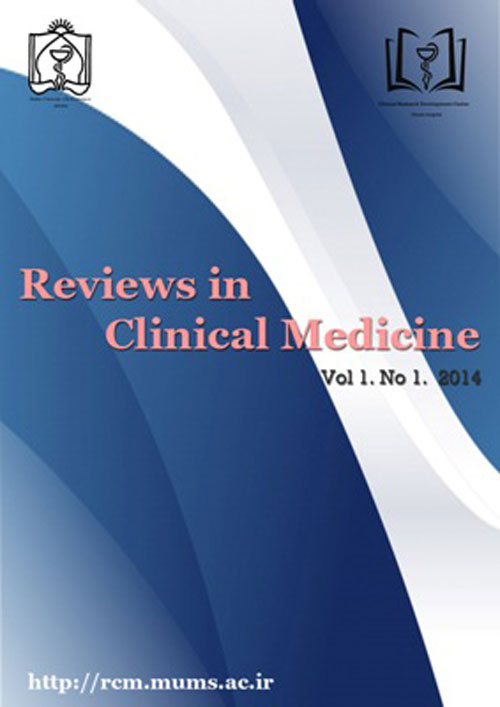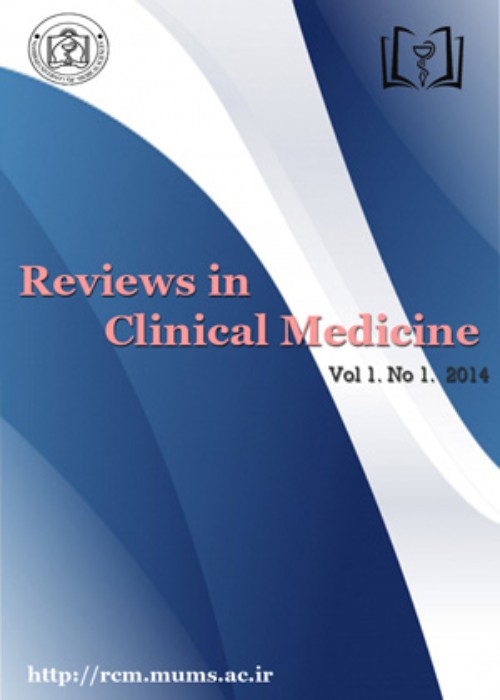فهرست مطالب

Reviews in Clinical Medicine
Volume:1 Issue: 1, Winter 2014
- تاریخ انتشار: 1392/11/17
- تعداد عناوین: 9
-
Page 1The Journal of Reviews in Clinical Medicine (RCM) is the leading journal of its type at Mashhad University of Medical Sciences covering all aspects of the natural and clinical sciences, which may be a matter of concern for the related specialists. The scope of the journal defines the RCM Publishing Group''s ambition to take a considerable step forward in constructing a valuable medical resource for both authors and readers. It offers the practical and the professional support for clinicians to spread the critical and constructive analysis in a specific field through extended explanations on the topic. In other words, it pragmatically provides the readers with recent advances and discoveries by means of previously published literature or data. Furthermore, the journal expects to generate the ideas of where the researches might go in the future. The RCM Publishing Group hopes to be a gateway to the positive outlook of research in any medical discipline. In this issue, we present the wide range of researches in different fields of medicine, which describe briefly below. Acute lymphoblastic leukemia (ALL) is one of the most common pediatric disorders that affected the large number of patients. Along with the high rate of treatment success, a modified and individualized diagnostic test can significantly increase the survival rate. Therefore, cytogenetic and molecular tests might play an important role in the prognosis of ALL by detecting the special genetic polymorphism affecting drug metabolism and its subsequent effective level and toxicity. Differential diagnosis between benign and malignant brain tumors has been a dilemma for appropriate management and treatment for years. Magnetic resonance spectroscopy is now addressing the need for noninvasive methods of measuring human brain function. Chronic kidney diseases such as renal failure are considered as the devastating medical problems in different age group. The long-term appropriate medical care especially nutritional support can exert a positive effect on patients` health. Furthermore, the use of tranexamic acid in cardiac surgery and its complications such as bleeding, the use of herbal medicine in the treatment of refractive seizure in children, the different causes of coma in pediatric medicine and also peripheral nervous system destruction occurred in systemic vasculitis has been discussed. Finally, we focus on cyclooxygenase 2 (COX2) as a major overexpressing enzyme in cancers. Thus, clinicians may consider COX 2 inhibitors as one of the therapeutic agents. The previous studies evaluated this role are reviewed in Wilms` tumor. Above all, we want to express our appreciation to all those who have submitted their manuscripts to RCM journal, all the Editorial board members and all the dedicated staffs for their loyal and precious cooperation. We look forward to attracting more specialists, residents and medical students to make RCM a really international and multicultural journal. Frankly, this has promised to be a far more difficult task than we anticipated. However, we will continue our efforts to take the first steps in this evolution more effectively.
-
Pages 2-6Acute lymphoblastic leukemia (ALL) is the most common type of neoplastic disorder diagnosed in childhood. It is the cause of one third of all pediatric malignancies. ALL is characterized by the abnormal production and proliferation of immature lymphoblasts in bone marrow (BM). It seems that ALL occurs due to a genetic mutation in DNA structure producing white blood cell (WBC) stem cells. Because ALL is a systemic disease, its primary management is based on chemotherapy. There are important risk factors responsible for the poor prognosis of ALL in children less than 1 year old and greater than 10 years old, such as: high WBC, mature T cell, mature B cell, central nervous system (CNS) involvement, DNA index < 1 (hypodiploid), triploidy, tetraploidy, Mixed-Lineage Leukemia (MLL) gene re-arrangement on 11q23, the Philadelphia chromosome t(9;22), reduction in platelet count, hemoglobin>10 at diagnosis, no remission at the end of induction therapy and Minimal residual disease at the end of consolidation therapy. Complications might appear during the treatment including tumor lysis syndrome, bleeding, renal failure, sepsis, seizure, thrombosis, etc. Some consequences might identify after a long-term follow-up such as learning impairment, growth retardation, and secondary malignancies. It is estimated that up to 90% of pediatric ALL cases are curable.Keywords: Acute lymphoblastic leukemia, Cytogenetic, Immunophenotype, Prognosis
-
Pages 7-11Serious bleeding in cardiac surgery leads to re-exploration, blood transfusion and increases the risks of mortality and morbidity. Using the lysine analogous of antifibrionlytic agents are the preferred strategy to suppress the need for transfusion procedures and blood products. Although tranexamic acid has been very influential in reducing the transfusion requirement after operation, tranexamic acid induced seizures is one of the common side effects of this drug. Due to inhibiting the fibrinolysis, thrombotic events are other possible side effects of using tranexamic acid. There are no certain results regarding decreasing the mortality rate by using the drug but it is identified that tranexamic acid does not increase the mortality. In this article, we aimed to review the literature on using tranexamic acid in cardiac surgeries.Keywords: Bleeding, Blood transfusion, cardiac surgery, Tranexamic acid
-
Pages 12-16Non-traumatic coma is a medical emergency and should be evaluated as soon as possible. Pediatric coma is more serious because of patient’s capacity of pathological stressor tolerance is limited especially in neonates. Several etiologies could be listed for loss of consciousness (LOC) and coma in childhood. According to the epidemiological studies, causes of coma are different all around the world. Glasgow Coma Scale has been used for coma scaling. In this review, we focused on some highlight causes of coma in pediatric medicine.Keywords: Coma, Glasgow Coma Scale, Pediatric
-
Pages 17-20The ability to differentiate neoplastic and non-neoplastic focal brain lesion is critical for appropriate management of patient. Specificity of magnetic resonance imaging (MRI) is low and does not provide adequate data to help the differentiation. Magnetic resonance spectroscopy (MRS) is one of the newly supplementary methods for determining molecular structures of compositions and is used for better differentiation among brain lesions. The applicability of MRI plus MRS in changing the histopathology is undetermined. In order to evaluate the ability of magnetic resonance spectroscopy combined with conventional magnetic resonance imaging, we reviewed related literature till 2013.Keywords: Focal brain lesions, Magnetic Resonance Spectroscopy, Neoplastic, Non, neoplastic
-
Pages 21-24In the last two centuries, chronic kidney disease (CKD) and renal failure (RF) have been considered as the main medical problems which were fatal in many cases. Trace elements such as selenium, copper, and zinc are the components of biological enzymes which have a crucial role in decreasing reactive oxygen. The levels of these trace elements reduce in CKD patients. Close and careful nutritional support of children with CKD, particularly in the early stages of the disease, is necessary.Keywords: Chronic kidney disease, Renal failure, Trace elements
-
Pages 25-28Primary systemic vasculitis in pre-capillary arteries is associated with peripheral neuropathy. In some types of systematic vasculitis about 60 % of patients have peripheral nervous system (PNS) involvement. In vasculitic peripheral neuropathies (VPN) a necrotizing and inflammatory process leads to narrowing of vasa nervorum lumen and eventually the appearance of ischemic lesions in peripheral nerves. Some features might be suggestive of VPN, like: axonal nerve degeneration, wallerian-like degeneration, and diameter irregularity of nerve. Peripheral nervous system (PNS) destruction during systemic vasculitides should be considered, due to its frequency and early occurrence in vasculitis progression. The first line treatment of non systematic VPNs is corticosteroid agents, but these drugs might worsen the VPNs or systemic vasculitis.Keywords: Mononeuropathy, Neuropathy, Vasculitis
-
Pages 29-32Epilepsy is described as a heterogeneous clinical syndrome results from various cerebral destructions. It is categorized to partial and generalized forms. Degree of neural system impairment and affected area determine the severity and pattern of symptoms. Patients might experience sensory, motor, or both signs and symptoms. About 60% of epileptic patients suffer from partial type. It is estimated that up to 30% of epilepsy cases would not be controlled adequately despite sufficient and proper management. Anacyclus pyrethrum, Citrus aurantium var. amara, Paeonia officinalis, Rosa Damascena and Nigella Sativa are some of herbal drugs which have antiepileptic effect. Natural agents are valuable sources to treat chronic diseases and a huge number of world`s population believe herbs are effective and safe for daily primary health care needs. There is not enough evidence about their efficacy and safety obtained from randomized control trials.Keywords: Children, Epilepsy, Seizure
-
Pages 33-37Cyclooxygenase 2 has become an important pharmacological target in anticancer therapy due to the over expression of COX 2 in pathological conditions. Wilms’ tumor is a common kidney cancer in children which has shown an increase in COX 2 enzyme level. Here we reviewed various articles that considered the cyclooxygenase 2 changes specifically in Wilms’ tumor regarding the mechanisms of action and inhibitors of COX 2.Keywords: Cyclooxygenase, Kidney, Prostaglandins, Wilm's tumor


